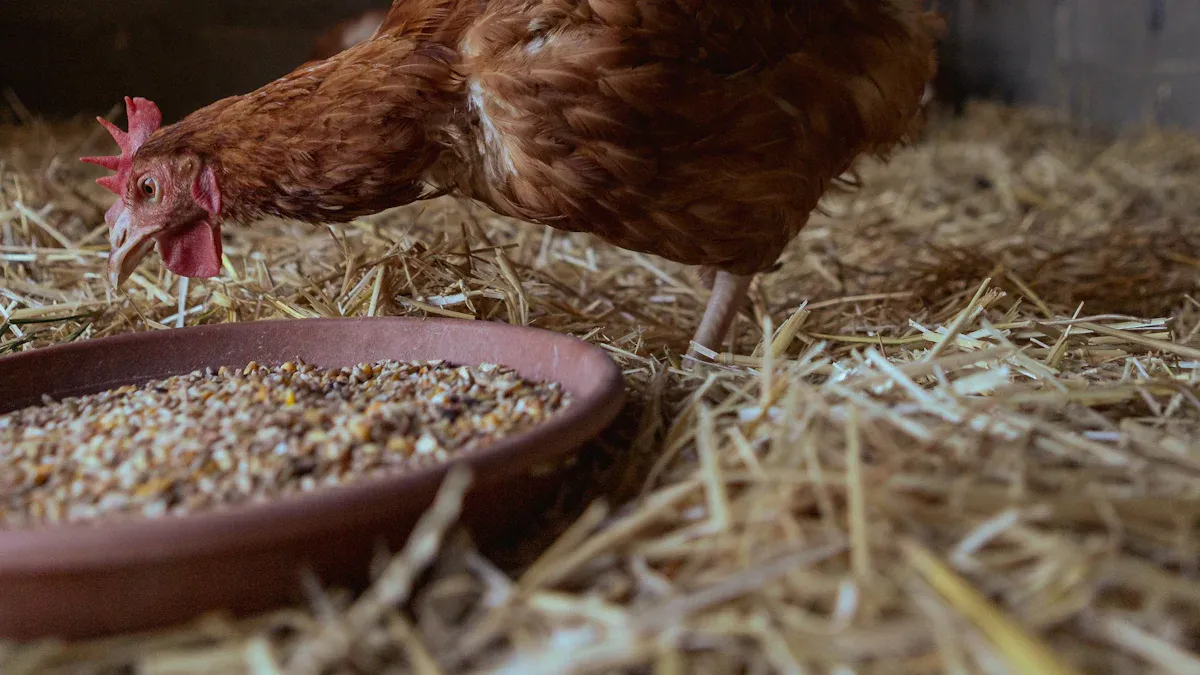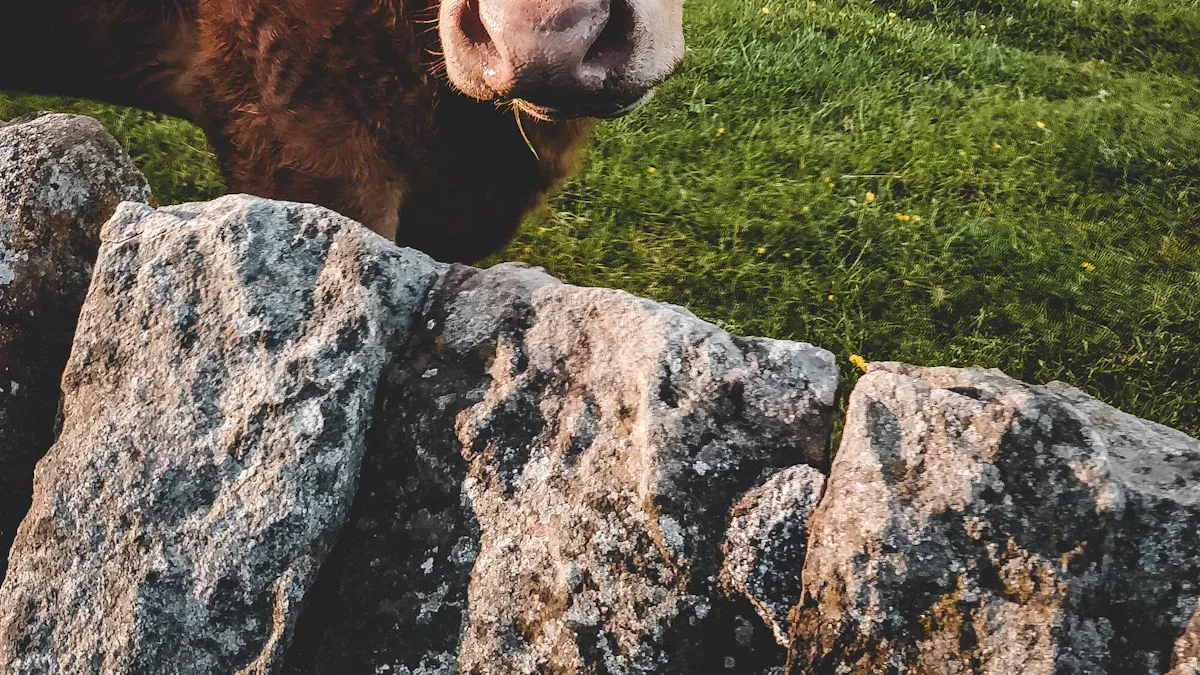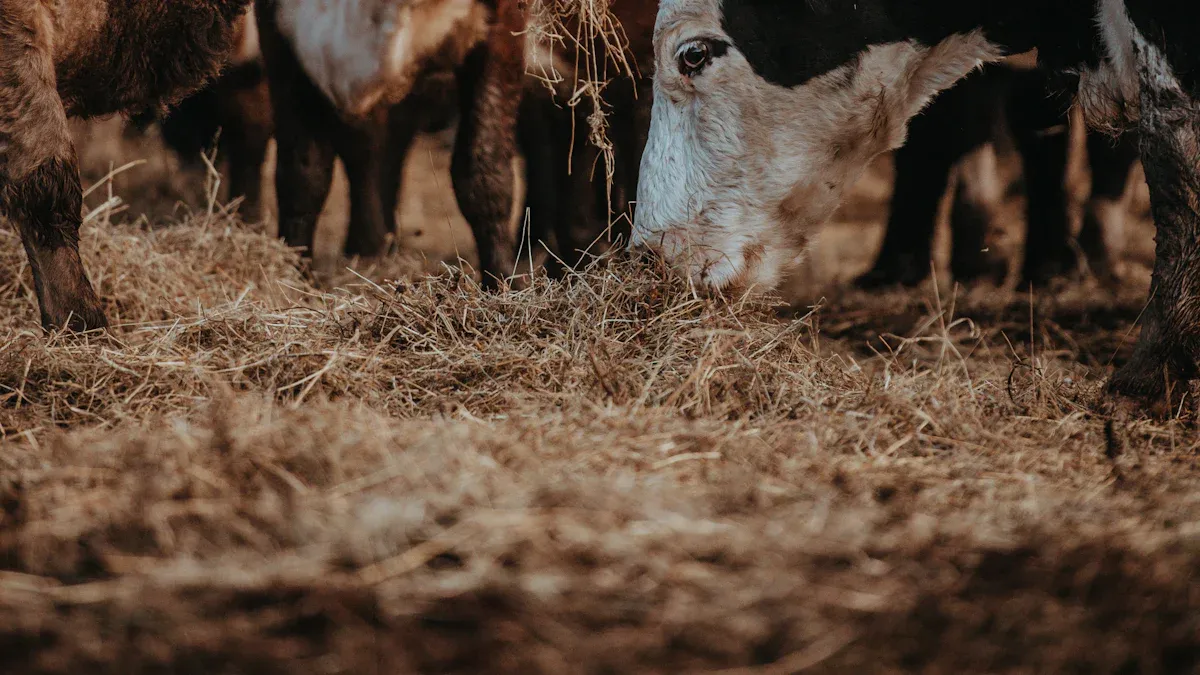
Sustainable feed solutions are becoming essential for livestock farming. The European livestock sector faces increasing pressure to improve its environmental impact, as highlighted by initiatives like the EU Green Deal. Dried mealworms for livestock offer a promising alternative. Packed with nutrients, they not only support animal health but also help address the growing environmental challenges of traditional feed production.
Key Takeaways
- Dried mealworms are a healthy feed choice. They have lots of protein and good fats that help animals grow strong and stay healthy.
- Using dried mealworms helps the environment. It lowers harmful gases and saves land used for farming.
- Growing mealworms cuts down waste. They turn leftover food into great protein, helping reuse resources.
Nutritional Benefits of Dried Mealworms for Livestock

High Protein Content and Livestock Growth
Protein plays a vital role in livestock growth, and dried mealworms deliver it in abundance. Their protein content surpasses many traditional feed sources, making them a powerhouse for animal development. Studies show that including mealworm meal (MWM) in livestock diets significantly boosts growth performance, especially in broiler chickens.
Here’s a closer look at the benefits:
| Evidence Type | Findings |
|---|---|
| Growth Performance | Inclusion of MWM in diets improves growth performance in broiler chickens. |
| Feed Conversion Ratios | MWM enhances feed conversion ratios compared to plant protein sources. |
| Carcass Quality | MWM contributes to better overall carcass quality due to its high-quality protein and balanced amino acid profile. |
Farmers looking to optimize growth rates and feed efficiency can rely on dried mealworms for livestock as a dependable solution. Their balanced amino acid profile ensures animals receive the nutrients they need for robust development.
Rich Source of Essential Fats and Micronutrients
Mealworms aren’t just about protein; they’re packed with essential fats and micronutrients that support overall livestock health. Their fat content is higher than many conventional feed options, offering a rich energy source for animals.
Key highlights include:
- Mealworms have a higher fat content compared to traditional mammalian sources.
- Their protein and fat qualities are comparable to or better than those from conventional livestock feed.
- Processing methods like drying and extraction help preserve their nutritional value.
These qualities make dried mealworms for livestock a versatile feed option. They provide energy and essential nutrients, ensuring animals stay healthy and productive.
Digestibility and Overall Health Benefits
Dried mealworms shine when it comes to digestibility. Livestock can easily break down their nutrients, leading to better absorption and overall health. Research shows that mealworms can replace fish or soybean meal without compromising growth performance or digestibility.
Here’s what studies reveal:
| Study | Findings |
|---|---|
| Jin et al. (2016) | Supplementation of weaning pig diets with up to 6% pulverized mealworm improved growth performance and nutrient digestibility. |
| Makkar et al. (2014) | Nutrient profile of mealworms is similar to fish and soybean meal, making them a good alternative for livestock feed. |
| Ramos-Elorduy et al. (2002) | Replacement of fish or soybean meal with mealworms resulted in similar or better growth performance and digestibility in poultry. |
By improving nutrient absorption, dried mealworms for livestock contribute to healthier animals and more efficient farming practices. Their digestibility ensures that every bite counts, maximizing the benefits for livestock.
Sustainability of Dried Mealworms for Livestock

Reduced Environmental Impact of Mealworm Farming
Mealworm farming offers a greener alternative to traditional livestock feed production. Unlike conventional protein sources, mealworms produce significantly fewer greenhouse gases. For example, studies show that mealworms emit far less carbon dioxide and methane compared to cattle or poultry farming. This makes them a more eco-friendly option for farmers looking to reduce their carbon footprint.
Additionally, mealworm farming requires less land, which helps preserve natural habitats. By using vertical farming techniques, mealworm production minimizes the need for large agricultural spaces. This approach not only conserves land but also supports biodiversity by reducing deforestation.
Farmers adopting dried mealworms for livestock can contribute to a more sustainable agricultural system. Their choice helps combat climate change while maintaining high-quality feed for their animals.
Lower Resource Use Compared to Traditional Feeds
Mealworm farming is incredibly resource-efficient. It uses fewer natural resources compared to traditional feed production methods. Here are some key comparisons:
- Greenhouse gas emissions are 23% lower in mealworm farming than in broiler production.
- Non-renewable energy use is reduced by 18%.
- Mealworm farming occupies 70% less agricultural land.
- Terrestrial acidification decreases by 72%.
Another advantage is the feed conversion efficiency of mealworms. To produce the same amount of edible mass, mealworms require only 3.61 kg of feed, while broilers need 4.91 kg. This efficiency makes dried mealworms for livestock a cost-effective and sustainable choice for farmers.
By using fewer resources, mealworm farming aligns with global efforts to create a more sustainable food system. It offers a practical solution for reducing the environmental impact of livestock farming.
Contribution to Waste Reduction and Circular Economy
Mealworm farming plays a vital role in waste reduction and the circular economy. These insects can thrive on low-value substrates, such as agricultural by-products and food waste. By converting these materials into high-quality protein, mealworms help reduce waste while creating valuable feed for livestock.
Here’s how mealworms contribute to sustainability:
| Mechanism | Description |
|---|---|
| Valorization of low-value substrates | Mealworms transform low-value materials into protein-rich biomass and by-products like fertilizers. |
| Conversion of food waste | Food waste becomes a resource for mealworm farming, reducing landfill contributions. |
| Plastic biodegradation | Mealworms can even break down certain plastics, aiding in waste management and material recovery. |
This innovative approach not only reduces waste but also supports a circular economy. Farmers using dried mealworms for livestock can take pride in contributing to a system that values resource efficiency and environmental stewardship.
Challenges in Using Dried Mealworms for Livestock
Regulatory and Legal Barriers
The regulatory framework for insect-based feed solutions can be tricky to navigate. In the EU, for example, strict food safety laws create hurdles for using dried mealworms for livestock. Regulations like 1069/2009 prohibit feeding insects with waste streams due to concerns about pathogens and chemical contamination. Additionally, insects must meet the same contamination standards as traditional animal feed under Directive 2002/32/EC. This means the safety of mealworms depends heavily on how they’re raised and what they’re fed.
These rules, while essential for safety, can slow down the adoption of mealworms as a mainstream feed option. Farmers and producers must stay informed about these legal requirements to ensure compliance and avoid setbacks.
Cost and Scalability Issues
Scaling up mealworm farming to meet livestock feed demands isn’t without challenges. High initial investment costs and the need for advanced farming technologies can make it difficult for producers to expand. Here’s a breakdown of the key issues:
| Challenge | Description |
|---|---|
| Scalability in Supply Chain & Production | Meeting large-scale demand for mealworms remains a challenge. |
| High Initial Investment Cost | Setting up insect farming facilities requires significant upfront capital. |
| Degree of Technologies in Insect Farming | Advanced technology is needed to optimize production and reduce costs. |
Despite these obstacles, ongoing advancements in insect farming technology could help address these issues over time, making dried mealworms for livestock more accessible to farmers.
Ensuring Quality and Safety Standards
Maintaining consistent quality and safety standards is critical for dried mealworms to gain wider acceptance. While studies show that heavy metal levels in mealworms are below safety limits, contamination risks still exist. Microbial contamination, such as Escherichia coli, has been observed, highlighting the need for better hygiene during processing. Other challenges include:
- Variability in moisture content, which affects shelf stability and microbial safety.
- The need for stricter drying protocols to ensure uniform quality.
Producers must prioritize rigorous quality control measures to build trust among farmers and regulators. By addressing these concerns, dried mealworms for livestock can become a reliable and safe feed option.
Future Prospects of Dried Mealworms for Livestock
Advancements in Insect Farming Technology
Insect farming technology has come a long way, and it’s only getting better. Innovations in automation and vertical farming are making it easier to produce mealworms on a large scale. Farmers can now rely on advanced systems to monitor temperature, humidity, and feeding schedules, ensuring optimal growth conditions for mealworms. These advancements not only improve efficiency but also reduce production costs over time.
The industry is also exploring ways to enhance the nutritional profile of mealworms. By tweaking their diets, producers can create mealworms with higher protein or fat content, tailored to specific livestock needs. With these technological strides, dried mealworms for livestock are becoming a more practical and scalable solution for farmers worldwide.
Potential Regulatory Changes and Market Expansion
The regulatory landscape for insect-based feeds is evolving. Policymakers are recognizing the potential of insects as a sustainable feed source and are working to create a more supportive framework.
- Regulatory changes could allow the use of more waste streams, making mealworm farming even more sustainable.
- Market studies suggest that replacing soy with insect protein could reduce costs and environmental impact.
- Calls for trials and partnerships with food retailers are gaining momentum, paving the way for broader market acceptance.
As global demand for animal products rises, the need for innovative feed solutions like insect-based products will grow. This shift could open up new markets and opportunities for mealworm producers.
Growing Awareness and Adoption Among Farmers
Farmers are starting to see the benefits of using mealworms as livestock feed. Many are drawn to the idea of reducing their environmental footprint while providing high-quality nutrition for their animals. Educational campaigns and pilot programs are helping farmers understand how to integrate mealworms into their feeding practices.
The numbers speak for themselves. A 2021 WWF report predicts that by 2050, the UK could demand 540,000 tonnes of insect meal annually, with much of it sourced locally. By 2030, the industry could produce 221,000 tonnes of dried insects, including mealworms. These figures highlight the growing role of insect protein in livestock farming.
With more farmers adopting this sustainable feed option, the future of mealworms in agriculture looks bright.
Dried mealworms for livestock offer a powerful combination of benefits. They provide high protein and fat content, support gut health with chitin, and thrive on waste products, reducing environmental impact. Insect farming avoids pesticides and antibiotics, making it eco-friendly. With advancing technology, mealworms promise a sustainable future for livestock farming.
FAQ
What makes dried mealworms a sustainable feed option?
Dried mealworms require fewer resources like land and water. They emit less greenhouse gas and can thrive on food waste, making them an eco-friendly choice. 🌱
Can dried mealworms replace traditional livestock feed completely?
Yes, they can replace traditional protein sources like soybean or fish meal. Studies show they provide similar or better nutritional benefits for livestock growth and health. 🐓
Are dried mealworms safe for livestock?
Absolutely! When produced under strict quality standards, dried mealworms are safe and free from harmful contaminants. Farmers can trust them as a reliable feed option. ✅

